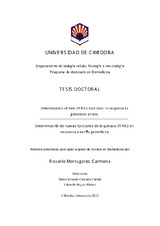Mostrar el registro sencillo del ítem
Determination of new DYRK2 functions in response to genotoxic stress
| dc.contributor.advisor | Calzado Canale, Marco Antonio | |
| dc.contributor.advisor | Muñoz Blanco, Eduardo | |
| dc.contributor.author | Morrugares Carmona, Rosario | |
| dc.date.accessioned | 2022-04-28T08:00:29Z | |
| dc.date.available | 2022-04-28T08:00:29Z | |
| dc.date.issued | 2022 | |
| dc.identifier.uri | http://hdl.handle.net/10396/22805 | |
| dc.description.abstract | Cancer is a complex disease enhanced by alterations in signaling pathways. In fact, DNA damage response (DDR) pathways play a key role in cancer development when they are deregulated. DDR pathways induce a cellular response that includes principally DNA repair pathways activation, cell cycle arrest, and cell death. Although there is a great knowledge of the signaling pathways that take place in DDR, further research is required to assess new molecular mechanisms for fully comprehend this complex scheme. In this sense, kinases like DYRK2, with an important role in DDR, are key to better understand and control DNA genomic damage situations. Thus, identification of new substrates for this kinase, as well as to elucidate novel pathways implicated in DDR would open a road to the development of new therapeutic strategies against cancer. In the present work we show NOTCH1 as a novel substrate for DYRK2. We describe for the first time a new regulation mechanism of the NOTCH1 signaling pathway mediated by this kinase. We demonstrate that DYRK2 phosphorylates Notch1-IC in response to DNA damage and facilitates its proteasomal degradation by FBXW7 ubiquitin ligase through a Thr2512 phosphorylation-dependent mechanism. We show that DNA damage-dependently triggered DYRK2 has a relevant effect on the viability, motility and invasion capacity of cancer cells expressing NOTCH1. In summary, we reveal a novel DRYK2-dependent mechanism of regulation for NOTCH1 which might help us to better understand its role in cancer biology. Besides, we attempted to overview of cellular circuits that are involved in ionizing radiation triggered DNA damage response in human dermal fibroblasts. To allow this, we employed three different approaches: RNA-seq and proteomic and phosphoproteomic analysis based on SILAC labelling. This is, to our knowledge, the first work that compare these 3 different functional approaches to this aim. The description of NOTCH1 as a new DYRK2 substrate, as well as the acquisition of solid data compilation that would permit a deeper understanding of the pathways that take place in response to ionizing radiation. This will provide new therapeutic opportunities for radiodermatitis prevention and treatment. Taken together, these data contribute to better understand the network of signaling pathways activationdeactivation under DNA damage conditions, opening a road to the development of new therapeutic strategies against cancer. | es_ES |
| dc.description.abstract | El cáncer es una enfermedad compleja que se ve impulsada por alteraciones en rutas de señalización. De hecho, las rutas de respuesta al daño al ADN juegan un papel esencial en el desarrollo de cáncer cuando se encuentran desreguladas. Estas rutas inducen una respuesta celular que incluye principalmente la reparación del ADN, el arresto del ciclo celular y la muerte celular. A pesar de que existe un amplio conocimiento de las rutas de señalización de respuesta al daño al ADN, una mayor investigación es necesaria para detectar nuevos mecanismos moleculares que nos permitan comprender este complejo entramado de señales. En este sentido, proteínas como DYRK2 son esenciales para entender y controlar situaciones de daño al ADN. Por tanto, la identificación de nuevos sustratos para esta quinasa, así como de nuevas rutas de señalización implicadas en la respuesta al daño al ADN podrían ser herramientas muy útiles en el desarrollo de estrategias contra esta enfermedad. En este trabajo mostramos cómo NOTCH1 es un nuevo sustrato de DYRK2. Describimos por primera vez un nuevo mecanismo regulatorio de la ruta de señalización de Notch por medio de esta quinasa. Demostramos que DYRK2 fosforila a NOTCH1-IC en la Thr2512 en respuesta a daño al ADN y promueve su degradación proteosomal gracias a la ubiquitinación por parte de la ubiquitín-ligasa FBXW7. Además, mostramos que el efecto de DYRK2 en respuesta a estrés genotóxico tiene un efecto relevante en la viabilidad, motilidad y capacidad de invasión de células tumorales que expresan NOTCH1. En resumen, mostramos un nuevo mecanismo de regulación de NOTCH1 por parte de DYRK2 que podría ayudarnos a comprender mejor su papel en la biología del cáncer. Además, hemos tratado de obtener una visión general de los circuitos celulares implicados en la respuesta al daño al ADN generado por radiación ionizante en fibroblastos. Para ello hemos analizado 3 niveles ómicos distintos: transcriptómico (por RNA-seq), proteómico y fosfoproteómico (empleando SILAC). Este sería hasta ahora el primer trabajo que emplea estas 3 aproximaciones diferentes para este fin. En resumen, en este trabajo se describe NOTCH1 como un nuevo sustrato de DYRK2, así como la adquisición de datos sólidos que permiten una comprensión más profunda de las rutas que se activan en respuesta al daño al ADN. En conjunto, estos data contribuyen a una mejor comprensión de las redes de señalización que se activan y desactivan en respuesta al daño al ADN, abriendo una puerta al desarrollo de nuevas estrategias terapéuticas frente al cáncer. | es_ES |
| dc.format.mimetype | application/pdf | es_ES |
| dc.language.iso | eng | es_ES |
| dc.publisher | Universidad de Córdoba, UCOPress | es_ES |
| dc.rights | https://creativecommons.org/licenses/by-nc-nd/4.0/ | es_ES |
| dc.subject | Cancer biology | es_ES |
| dc.subject | Carcinogenesis | es_ES |
| dc.subject | Signaling | es_ES |
| dc.subject | Kinases | es_ES |
| dc.subject | DNA Damage Response | es_ES |
| dc.subject | DYRK2 | es_ES |
| dc.subject | NOTCH1 | es_ES |
| dc.subject | Genotoxic stress | es_ES |
| dc.title | Determination of new DYRK2 functions in response to genotoxic stress | es_ES |
| dc.title.alternative | Determinación de nuevas funciones de la quinasa DYRK2 en respuesta a estrés genotóxico | es_ES |
| dc.type | info:eu-repo/semantics/doctoralThesis | es_ES |
| dc.rights.accessRights | info:eu-repo/semantics/openAccess | es_ES |

